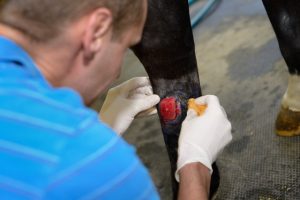New Aid to Wound Healing

Veterinarian cleaning and sterilizing granulating wound on hind leg of thoroughbred horse with iodine. – AdobeStock image.
From Equine Science Update:
Recent research suggests that a synthetic skin spray could aid in wound healing by limiting the formation of exuberant granulation tissue.
Due to their nature, horses are prone to injuring themselves. Wounds on the lower legs are particularly likely to heal slowly, often involving exuberant granulation tissue (EGT). This excessive tissue growth, commonly known as “proud flesh,” poses a significant challenge to equine wound management, as it hampers further healing by protruding from the wound site.
A team of researchers based in France has been investigating the efficacy of a novel synthetic epidermis spray (SES)* in promoting wound healing. Led by Charlotte C Paindaveine from the Ecole Nationale Vétérinaire de Lyon, the researchers conducted a small-scale clinical trial to compare the healing outcomes of experimental surgical wounds treated with SES spray versus those treated with a standard bandaging technique.
The study, detailed in a report published in PLoS One, involved creating standardised surgical wounds on the lower limbs of six adult Standardbred mares. These wounds were then subjected to treatment with either SES or a traditional bandaging method.
For the SES treatment, the spray, which comprised ultraviolet polymerizable methacrylate monomers, comonomers, crosslinker and a photoinitiator was applied to the wound. The researchers explain that this layer was then polymerised using a 395 nm, 20 x 30 cm, 40 mW/cm2 UV light for 60 seconds at a distance of approximately 30 cm (Fig 1). They repeated the same procedure to fix a second layer of the product. The SES was only applied on day 0. No further application was made.
The control treatment consisted of a nonadherent permeable dressing secured with conforming cotton gauze and held in place with a cohesive bandage, which would be a common treatment of choice for superficial wounds in a field setting. The control treatment was repeated every 4 days until the end of the study to mimic field veterinary follow-up.
Wounds were assessed daily for the SES treatment group, and every 4 days for the control / bandaged group.
The researchers report that the synthetic epidermal spray allowed healing without the production of EGT but it did not reduce the median wound healing time compared to a standard bandaging technique.
They add that the exuberant granulation tissue observed in the control group that did not receive the SES decreased without any trimming procedure during the 60-day period.
They conclude: “The SES is potentially an interesting alternative for the management of secondary intention wound healing of superficial and non-infected distal limb wounds in adult horses because of its economical and practical aspects.
*Novacika®, Cohesive S.A.S, France
For more details, see:
Charlotte C. Pandaveine, Benoit Bihin, Olivier M. Lepage (2024)
The effects of a synthetic epidermis spray on secondary intention wound healing in adult horses. PLoS ONE 19(3): e0299990.










